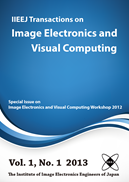Volume 9, Issue 2
Displaying 1-5 of 5 articles from this issue
- |<
- <
- 1
- >
- >|
Contributed Paper -- Special Issue on Journal Track Papers in IEVC2021 --
-
Article type: Contributed Paper -- Special Issue on Journal Track Papers in IEVC2021 --
2021 Volume 9 Issue 2 Pages 41-49
Published: December 15, 2021
Released on J-STAGE: March 20, 2023
Download PDF (42850K) -
Article type: Contributed Paper -- Special Issue on Journal Track Papers in IEVC2021 --
2021 Volume 9 Issue 2 Pages 50-57
Published: December 15, 2021
Released on J-STAGE: March 20, 2023
Download PDF (7347K) -
Article type: Contributed Paper -- Special Issue on Journal Track Papers in IEVC2021 --
2021 Volume 9 Issue 2 Pages 58-68
Published: December 15, 2021
Released on J-STAGE: March 20, 2023
Download PDF (7509K) -
Article type: Contributed Paper -- Special Issue on Journal Track Papers in IEVC2021 --
2021 Volume 9 Issue 2 Pages 69-77
Published: December 15, 2021
Released on J-STAGE: March 20, 2023
Download PDF (4747K)
Contributed Paper
-
Article type: Contributed Paper
2021 Volume 9 Issue 2 Pages 78-85
Published: December 15, 2021
Released on J-STAGE: March 20, 2023
Download PDF (1477K)
- |<
- <
- 1
- >
- >|
